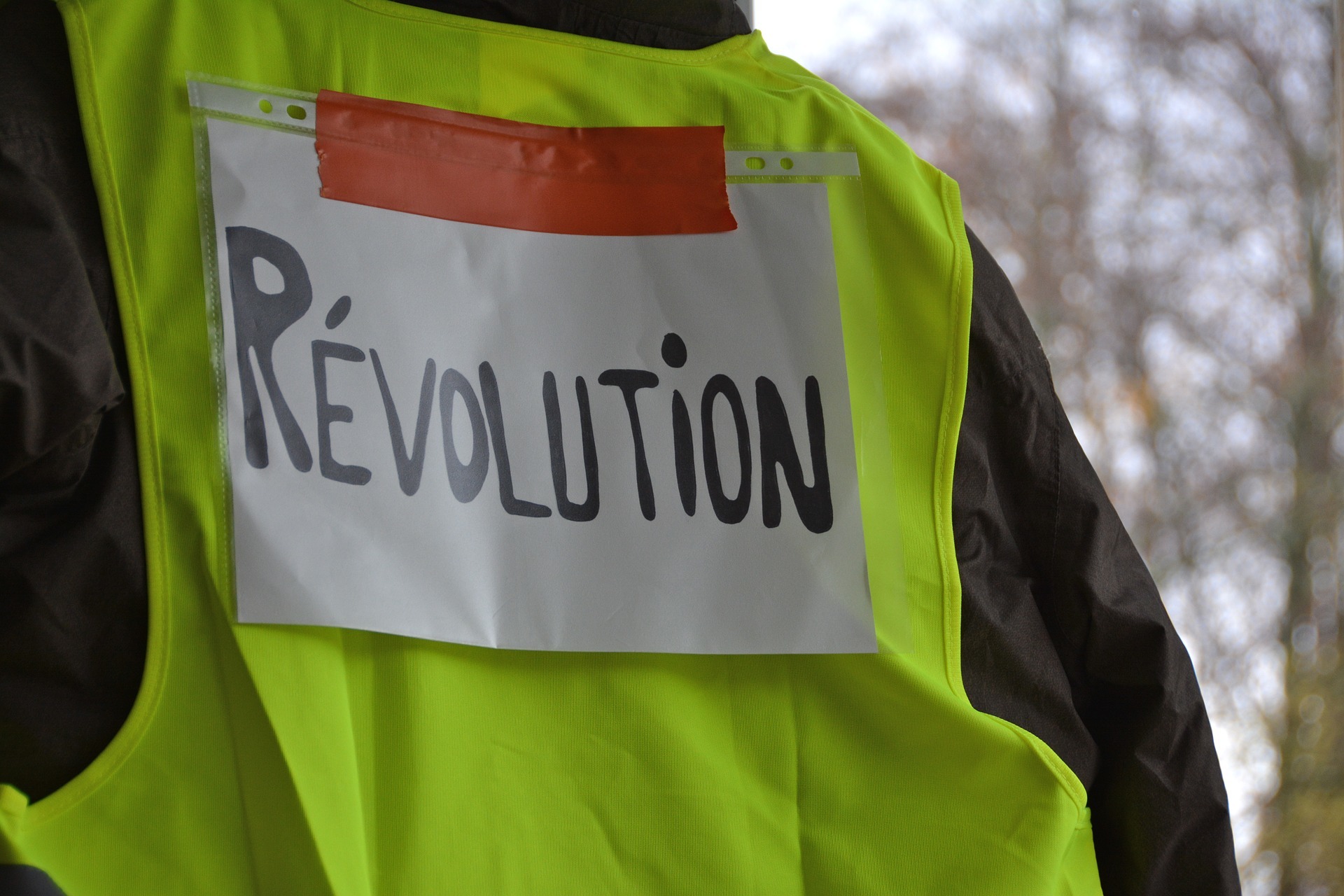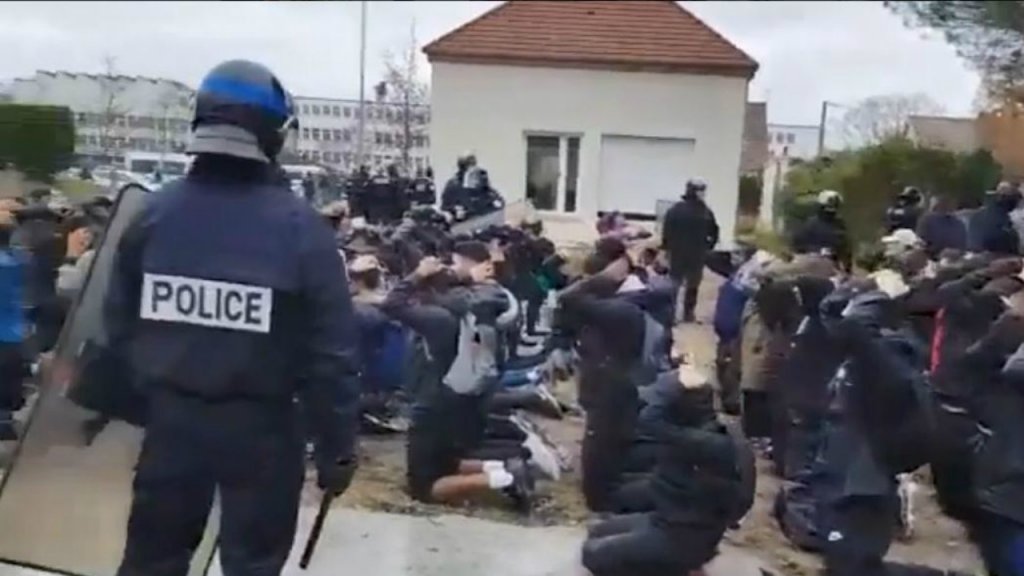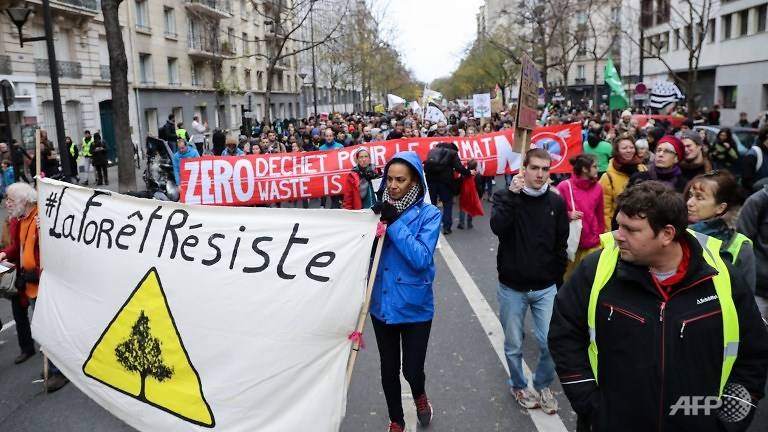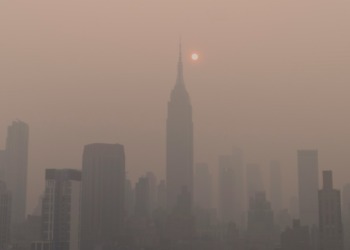Article updated 17 February 2019: protests are petering out, down to 45,500 in the 14th week since they began – they peaked at 282,000. Meanwhile Macron’s popularity has risen to 34% according to the latest Paris Match poll. Macron condemned the protesters’ anti-Semitism as leading French writer and academician Alain Finkelkraut came under attack on 16 February and was saved by the police.
The Yellow Vests protests were massive at first and the language was violent – revolutionary. “He deserves to have his head chopped off, symbolically,” said Claudio, a 47 year-old mason and father of four (last name withheld), referring to French President Macron who has been often accused of draping himself in the symbols of pre-revolutionary France. Claudio lives in the northern town of Le Mans famous for car racing. Like many Yellow Vests, he likened their protests to the 1789 French Revolution. That, of course, is wishful thinking.
But wearing “Gilets Jaunes”, the yellow vests (roadside safety vests required by law) was a stroke of genius. It made protesters highly visible both on the road and in the media. Ever since they began on Saturday 17 November 2018, that is all one sees on our screens: yellow vests.
It turns out that Macron’s tax hikes on diesel fuel was the straw that broke the camel’s back and fueled the Yellow Vests’ anger. For them, what is at issue is fiscal justice. They can’t stomach his decision to raise taxes on pensioners at the same time that he scrapped wealth taxes. No matter he meant them as a tax break for investors to encourage them to invest in French business (notoriously under-invested) and create jobs.
The decision was perceived as unfair by the working classes, bogged down by taxes while the rich evades them, escaping to fiscal paradises. Macron is seen as “the president of the rich”. Out to impoverish the middle class.
“The guy thinks he’s God!” exclaimed Claudio, exasperated, as he dug in at a blockade outside a fuel depot of Le Mans, fortifying barricades. Along with some 50 companions, he is preparing for a long winter of discontent.
On the third Saturday (1 December), while Macron was at the G20 in Argentina, the protests unexpectedly turned Paris into a war zone, with small groups of “casseurs” burning cars, vandalizing monuments and breaking into stores and pillaging. In the midst of his G20 press conference, no doubt compelled by the horrifying images on everyone’s screens, Macron mentioned the Gilets Jaunes, solemnly stating he would always “respect protests” and “never accept violence”.
After his return from Argentina, on Monday, Macron called an emergency government meeting to address the issue and he toured Paris to survey the damage done to monuments. On Tuesday, because protests are not limited to the capital, they are widespread across the country, he went to visit government offices torched by protesters in Puy-en-Velay, a town in the center of France. He was heckled and booed everywhere he went.
That same Tuesday Prime Minister Edouard Philippe announced policies to assuage Yellow vests demands: fuel tax hikes are abandoned, there will be no surcharge on gas and electricity through May. These measures were immediately disparaged by the Yellow Vests as “mesurettes” (small measures).
Everyone expected a devastating Act IV on Saturday 8 Dec, the fourth week into the protests. Consequently, 89,000 agents, police and gendarmes, were mobilized and the strategy changed from defensive to offensive. Suspected “casseurs” (vandals) were stopped early in the day when coming to town to protest and arrested if carrying weapons. Crowds were tactically contained before the violence could get out of control.
The new strategy worked. Eventually, there were 125,000 protesters across France as against 136,000 the week before, and 10,000 in Paris. There were 118 wounded – much less than the 633 tally of the previous Saturday.
But there were many more arrested, 1220 as against 372 the week before, over half of them in Paris (619). Their profile is likely to be the same in both events. For now, we only know from police reports the profile of those arrested the Saturday before. There were three kinds: small groups of genuine “casseurs” from the extreme left, similar small groups from the extreme right, and a number of Yellow Vests “involuntarily” caught up in the violence, most of them men relatively mature (30 to 40 years) and “well-integrated socially” – meaning they had a job and family. Only 33 (about 10%) were minors.
By nightfall on Saturday 8, Prime Minister Edouard Philippe made a short positive statement on television: The French state did not “vacillate”, Macron will “announce measures to “reknit unity”. He didn’t say when he would do so, but everyone expects him to speak this coming week.
From a public security standpoint, the result was positive. But politically it was a win for the Yellow Vests: The media spotlight stayed on their grievances. It became clear to observers that this was a mass movement. Facebook is awash with their grievances, hundreds of them, many extreme and totally unrealistic, like asking for the suppression of the Senate or calling for a referendum to get Macron to resign. Yet what it boils down to is a cry for fiscal justice.
Whe the protests started, Macron’s approval rating stood at an all time low, 23 percent according to an IFOP poll. People were predicting he would end like Sarkozy, the right-wing President who by the time he’d left office in 2012 was the most unpopular president ever – only to be beaten in this race downwards by his Socialist successor, Hollande, who sank as low as 4 percent.
But by the 13th week of the protests, they were down to just 51,000 people all across France, about one fifth of what they were when they started. Meanwhile Macron’s rating was beginning to recover, the latest Paris Match poll (February 2019) put it at 34%. It didn’t help the Yellow Vests’ image that their demands have now become amorphous (focused on “food essentials”) and that their demonstrations are regularly infiltrated by “casseurs”.
The only thing that remains permanently changed: His image as a “Jupiterian” president.
“The Napoleonic method which worked at first for launching Macron’s reforms is no longer working,” Philippe Moreau-Chevrolet, a specialist in political communication, told AFP. Many observers think the turning point was the Benalla bodyguard affair last July (Benalla was accused of violence). From that moment on, Macron stopped listening to anyone. Now he is accused of not having listened to Gilets Jaunes demands and of moving only after they ran amok in Paris on 1 December.
Update 11 February 2019: News of increased violence in the first Saturday of the new year hit headlines around the world – but the number of people involved was far less: some 80,000, with many more in the provinces than Paris (Bordeaux topped the list with some 5,000 protesters). The violence however surged, with the Ministry for Relations with Parliament targeted, the main entrance door pulled down and the Minister (a close adviser to Macron) escaping through a back door.
A month later, at the movement entered its 13th week (Saturday 9 February), it was down to some 50,000 protesters with only 40 arrests – with many “casseurs” among them. And an ever more diffuse series of demands, moving from fuel to “food essentials”.
Anyone who hoped for politicization of the movement was disappointed: It continued to descend into pointless violence, opening itself to a stern reaction from the State authorities, with likely full support from French public opinion. Support is still high, around 55% in February 2019, but soon enough, one can expect the movement to peter out, though the discontent in the provinces, rooted in real inequalities that have existed over decades, will doubtless remain.
The Yellow Vests episode even if it ends soon, has some interesting lessons to impart, particularly regarding the rising role of social media as a major disrupter.
How Facebook Fueled the Yellow Vests Protest
There is little doubt that the tax hike on diesel was instituted in a precipitate and insensitive manner. Yet the government merely viewed it as the next logical step in its ecological policy, part of the “energy transition plan” for the decade to come.
The policy badly backfired on Facebook. And the social network was used to do what digital social networks do best ever since the Arab Spring: Bring protesters together in virtual online groups and help them plan their next moves.
According to the French media, it all began in October as fuel tax hikes were heatedly debated, with one 51 year-old woman’s Facebook video giving “Monsieur Macron” a list of grievances that included the rising price of diesel, traffic radars and congestion taxes to limit urban traffic, and calling for others to make their own video “to say that you have had it”. That video got over 6 million viewers and 263,000 shares. A petition asking for the tax hike to be canceled got over one million signatures.
Once again, Facebook played a huge role in sparking the revolt, making the coordination of protest action possible across France. Bloomberg quickly titled: “Street riots in Paris are less about a tiny fuel tax hike than the power of social networks to radicalize their users.”
Like so many other “bubbles of protest” you find on Facebook, the Yellow Vests movement grew with emotional videos and fake news, including videos about other unrelated protests and unfounded “news”, for example that the French police impersonated protesters to make the riots look worse and give the government a pretext for crackdown.
What is striking, as the French media expert says in this video, is that this is a mass movement, grassroots and faceless as a direct result of it being born on Facebook:
Other aspects of the movement – the anger expressed, the emotions – are typical of Facebook, as Olivier Ertzscheid, a university researcher told Agence France-Presse:
#giletsjaunes : Facebook est « un ascenseur de la colère sociale » qui « souffle sur les braises » https://t.co/FAxQfDFfqr Entretien avec @affordanceinfo par @JulieJammot #AFP pic.twitter.com/Wqj4rUxwfD
— Agence France-Presse (@afpfr) December 7, 2018
This roughly translates as: “Facebook is “an elevator of social anger” that “blows over the embers”. The article further explains that “emotions linked to anger” are those that “spread the best on the platform”. They are “mechanisms of virality”. Facebook is a formidable “tool for democracy” without which the Yellow Vests’ grievances would never have grown so much. But, Ertzscheid warns, Facebook makes victory impossible: Its algorithms are designed to “add oil on the fire”, to multiply grievances and provide tools – like groups – to organize protest. Not to come to a resolution.
This analysis has many in agreement, including Buzzfeed that has called the Yellow Vests protest “a beast born almost entirely from Facebook”. A change in Facebook’s new algorithm is under accusation. It appears that since January 2018 Facebook gave less importance to outside links. This was a way to reduce partisan squabbles and contain fake news on the platform. Instead, Facebook users are encouraged to share their own news with family and friends and through semi-private groups.
Others disagree, for them little has changed in how Facebook functions. “Some in Paris have suggested all Yellow Vests are driven by fake-news and conspiracy theories on Facebook, & are somehow uneducated,” Guardian Paris bureau chief Angelique Christafis tweeted on Friday morning. “That was not what I found and it would be a mistake to think that…”
What happened was this:
- The protesters’ grievances are real, they are not Facebook-fueled fake news;
- Yet Facebook played a fundamental role: it gave a voice to “l’autre France”, the “France Profonde”, the France outside Paris that is forgotten by the political parties, Macron’s LREM included; a couple of journalists investigated and wrote books about it in 2017 – but outside of such specific books and polls, no newspaper gives voice to them; their grievances are mostly heard on the social networks, Facebook and Twitter.
This week, Facebook continues to play a key role in expanding the protest movement to other segments of the population.
Carried Forward by Facebook, Yellow Vests Protests Expanded Until January 2019
Yellow Vests protests rapidly expanded to farmers, students and paramedics. All carried forward on Facebook. Thursday (6 Dec), a video showing students kneeling in the mud, harassed by overbearing police went viral. The students are copying the Yellow Vests but they have in fact their own reasons to protest: Macron’s educational reforms.
Screen capture from video showing teenage student protesters forced by police to kneel in mud, their hands behind their heads – in Mantes La Jolie, Yvelines 6 Dec 2018. Source: France 24
The next day lycée students in Paris kneeled on the sidewalk in Place de la République :
#instantané Des lycéens s’agenouillent, mains derrière la tête, place de la République à Paris, en soutien aux 151 jeunes interpellés hier aux abords d’un lycée de Mantes-la-Jolie ???? @philippe_lopez #AFP pic.twitter.com/MRJSPghxMF
— Agence France-Presse (@afpfr) December 7, 2018
The gesture was repeated in the following Saturday protest in Paris.
Predictably, Macron’s opposition from Marine Le Pen on the right to Benoit Hamon on the left (he is the founder of a new leftist party Génération.s) tried to exploit the situation and connect with protesters. Hamon tweeted “French youth humiliated”:
Glaçant, inadmissible. Cela n’est pas la République. La jeunesse Française humiliée. Mais que cherche le pouvoir sinon la colère en retour ? https://t.co/NJ9N0saBs5
— Benoît Hamon (@benoithamon) December 6, 2018
The whole spectrum of political opposition joined in with similar tweets, including the Greens and Mélanchon’s far left France Insoumise .
But can the protesters be politicized?
It doesn’t look likely – and by February 2019, in spite of various efforts from Yellow Vest activists here and there, they still weren’t. Strikingly, the Yellow Vests, from the start, have rejected all parties and so far they remain resolutely anti-establishment. For now, the young are likewise impervious to political calls.
Also, student protests are endemic and recurrent in French political life every time efforts are made to reform the educational system. The link with the Yellow Vests is practically non-existent. It is merely a case of jumping on the bandwagon of popular protest to make oneself heard. But the message of protest is not the same. How could it? Fiscal justice is a concern of workers, of those who pay taxes – not students.
Are the Yellow Vests Part of a Global Protest Against Climate Change Taxes? Or Against the Establishment like Trump’s fans?
In the four weeks since it started, the small Yellow Vests protest morphed into a vast, nationwide anti-Macron uprising. It is a movement of resistance that has two distinct roots:
- The institution of fuel taxes to sustain the fight against climate change; this was quickly picked up by American observers who saw a link with Trump’s fan base in the rust belt; Trump himself fueled this view with a couple of tweets on Tuesday. This is the first:
I am glad that my friend @EmmanuelMacron and the protestors in Paris have agreed with the conclusion I reached two years ago. The Paris Agreement is fatally flawed because it raises the price of energy for responsible countries while whitewashing some of the worst polluters….
— Donald J. Trump (@realDonaldTrump) December 4, 2018
His second tweet totally overlooked the damage his pro-coal policies are doing to the environment – not only affecting America but eventually the whole planet, he claimed he was “making great strides”:
….in the world. I want clean air and clean water and have been making great strides in improving America’s environment. But American taxpayers – and American workers – shouldn’t pay to clean up others countries’ pollution.
— Donald J. Trump (@realDonaldTrump) December 4, 2018
Nobody asked America to “pay to clean up others countries’ pollution” (sic). That is not what the Paris Agreement is about, presumably Trump hasn’t read it. He makes America look like it doesn’t care what happens to the planet and humanity’s future.
Yet, many Americans do care. As Harvard Professor N. Gregory Mankiw told the Washington Post: “Higher taxes on energy have always been a hard sell, politically. The members of the American Economic Association are convinced of their virtue. But the median citizen is not.” Carbon pricing may be the logical way to go but, as Macron learned this week, it leads to “political explosions”.
True but this overlooks the fact that a majority of the French, the “France profonde” included, do believe in the reality of climate change. As one Yellow Vest protester, a woman in Alsace, told France 2, “we are not against ecology”. Remarkably, on Saturday afternoon in Paris (8 Dec), many Yellow Vests left the Champs Elysées when they saw that protests were turning violent, and crossed town to the Place de la République to join a highly successful March for Climate. It attracted 25,000 green activists as against the 10,000 Gilets Jaunes. Many yellow vests were seen marching along them:
People hold a banner reading “the forest resists” as they take part in a march against climate change, in Paris, on Dec 8, 2018. Two Gilets Jaunes are visible on the right, a few more on the far left of the picture. Source Photo: AFP/Jacques Demarthon; article at Channels News Asia.
The French are not particularly against a “green energy” transition plan as such.The problem is this: They feel that they are unjustly asked to pay for it and they can’t; taxes on fuel are already high in France. The “small guy is squeezed”. He can’t get to work in his car, he can’t deliver goods with his truck. What is required is an “equitable effort”: Macron’s policies are seen as weighing “90 percent on the poor” and 10 percent on the wealthy.
- Macron’s pro-business, neo-liberal policies. At first sight, the Yellow Vests protests look like they jumped straight out of Trump’s fan base: They share a feeling of resentment against the establishment, they see themselves as the victim of globalization, they fear losing their middle-class status. Pressured by austerity policies put in place by Germany and the European Union since 2010, they struggle with small, often temp jobs and have a hard time to make ends meet.
The problem is the high cost of life and lack of purchasing power. The top 20 percent earns five times as much as the bottom 20 percent. Macron’s political mistake? He had planned to use the revenue raised from the fuel tax to reduce the budget deficit. It would have been wiser to recycle it back to help lower and middle income households.
A political smart move would be to make sure that the fight against climate change is paid for by those who can afford it, the rich and big corporations. They are, in any case, the ones most responsible for the climate disaster.
Because of this anti-establishment feature, Yellow Vests protests resonated quickly in the rest of Europe. First extending to Belgium: A few hundred Yellow Vests were seen in Brussels in the last two weeks. Some even predict it will be coming to the UK.
But the protests are in fact deeply rooted in France. In a way, the Yellow Vests look like a uniquely French version of the Occupy Wall Street movement, this time carried out not by young progressive-leftist students but by middle-age blue-collar workers. The kind of people that were once active in trade unions but no longer are. In fact, trade unions have now nearly disappeared in France, with only 8 percent of employees in unions.
Just as the Yellow Vests reject any advances from political parties, they reject trade unionists. They have no leaders, just an endless list of (often contradictory) grievances. A shapeless mass movement, almost anarchic, that shows no sign into turning into a political party, enabling political dialogue. But it is very large, able to mobilize 250,000 in the streets, which suggests that up to ten million French could be involved. So how can Macron respond?
Can Macron Save His Presidency from the Yellow Vests?
Grievances are many but what holds the Yellow vests together are essentially grievance over the cost of living. The political problem is huge on two counts.
One, the protest is widespread across France, and just as active in the province as in Paris. For example, in Lyon, about 100 Yellow Vests forced the entrance of the headquarters of one of the most important regions of France, Auvergne-Rhone-Alpes seeking to speak to the authorities:
#Lyon: des ” #giletsjaunes ” reçus au siège de la @auvergnerhalpes après en avoir forcé l’entrée https://t.co/eZCvfyBOXr #AFP
???? @JpKphotographer @AFPphoto pic.twitter.com/I2lkh30Zc0— AFP Lyon (@AFPLyon) December 7, 2018
Should the government respond regionally? Locally? And if so, how can Macron coordinate the response?
Second, there is NO dialogue with the government at the top. The government tried to approach “moderate Gilets Jaunes” twice, but both time to little avail. Tellingly, the first time, when eight spokespersons were invited to the Elysée, only two turned up. And one immediately left complaining, in a stunning display of naiveté, that his request that the negotiations be streamed on Internet was rejected. The last thing anyone involved in high-level negotiations would want is to have them streamed to the public in real time – making it impossible to backtrack or hide a mistake. But it does show how far people have absorbed the Facebook way of life, the need for constant public display and non-stop sharing of one’s emotions.
The government is organizing “conferences” across the “territories” across France. The goal is to arrive at jointly at agreed policies over the next three months. Some mayors are reportedly suggesting that registries for complaints, “cahiers de doléances”, be established locally. Opening a forum for complaints online, for example an official “forum de doléances” on Facebook, might have been a good alternative way for the government to reach out. This was, however, tried by privates (not the government) with limited success: Only 248 likes and a call on February 9, 2019 to help “save” the page from oblivion:
Time is running out. By the end of 2018, the impact on the economy was beginning to show, as French TV France 24 titled: “protests knock wind out of French economy”. Fuel supplies were hit (through blocking fuel depots). So were schools, tourism, businesses, everything from retail to car manufacturers like Citroen and Peugeot. According to Finance Minister Bruno Le Maire, for small retailers, revenues had fallen between 20 and 40 percent; reservations in hotels were down 15 to 25 percent; in restaurants, depending on their location, they were down between 20 and 50 percent.
The Economist remained optimistic – the French economy can of course withstand much worse. In its latest issue (8 Dec) The Economist noted “all is not lost for Mr Macron”. What is needed are “the right policies, the right politics and, above all, a dose of humility could yet save his presidency”. But, “along the way, Mr Macron forgot that democracy requires the constant forging of consent.” And it also reminded its readers that even if Macron won the presidency, the opposition – populist Marine Le Pen on the far right, Mélanchon on the far left – had still obtained 48 percent of the votes in the first round of presidential elections. And both were quick to express support for the Yellow Vests.
Unsurprisingly, 75% of the French supported the Yellow Vests when the movement started. By year end, following the violence displayed by the protesters, support has dropped to 68% – a level where it looks stable , an obvious cause of concern for Macron. By February 2019 (in its 13th week), the Yellow Vests movement still had considerable support: from 55% of the French, according to the latest polls. Still, 29% are opposed and 16% indifferent.
Can Macron still craft a social compact that will satisfy the French? A “new social compact” needs to address two widely divergent goals: achieve a green economy and a fair economy that ensures everyone has a job and a fair start in life. The French President made it clear that he was aware of the challenges in his address to the nation on Monday 10 December 2018:
Will that speech and the new measures he proposes be enough to quell the protests? The New York Times titled “Contrite Macron, Confronting Protesters, Promises Relief to France”. He did not scrap his tax incentives for investors that he sees as indispensable to create jobs. But he did announce a series of concessions to the Yellow Vests demands: workers year-end bonus that won’t be taxed, ending levies on overtime, government funding for a 100-euro-a-month increase in the minimum wage and abolishing a controversial tax on pensions below 2,000 euros a month.
This is much more than “relief”. What he is proposing is a new social compact to be arrived at through an in-depth, long-term dialogue with all parts of civil society – from the Yellow Vests in the France Profonde to wealthy investors in Paris. The objective is to arrive at a set of final solutions that would amount to a break with the past.
The big question is whether he will obtain the “dialogue” he wants, whether his party can actually reach out to everybody. He plans on relying on town mayors since they are closer to the ground. But that may not be enough. Consideration should also be given to using social networks since that is where the Yellow Vests protest was born and organized.
One thing is certain: France is going in a new direction, using untrodden paths to devise totally new policies to achieve social justice. The struggling middle class and working poor, the France Profonde, the Other France, have been overlooked and left behind for far too long. We are far from neo-liberalism here.
So far, this is a challenge no country in the world has yet resolved, and certainly not Trump’s America. Can France (and Macron) do it?












